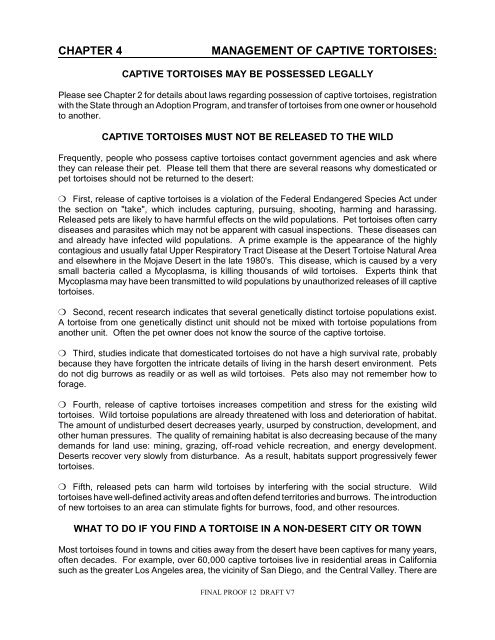Answering Questions About Desert Tortoises - Desert Managers ...
Answering Questions About Desert Tortoises - Desert Managers ...
Answering Questions About Desert Tortoises - Desert Managers ...
You also want an ePaper? Increase the reach of your titles
YUMPU automatically turns print PDFs into web optimized ePapers that Google loves.
CHAPTER 4MANAGEMENT OF CAPTIVE TORTOISES:CAPTIVE TORTOISES MAY BE POSSESSED LEGALLYPlease see Chapter 2 for details about laws regarding possession of captive tortoises, registrationwith the State through an Adoption Program, and transfer of tortoises from one owner or householdto another.CAPTIVE TORTOISES MUST NOT BE RELEASED TO THE WILDFrequently, people who possess captive tortoises contact government agencies and ask wherethey can release their pet. Please tell them that there are several reasons why domesticated orpet tortoises should not be returned to the desert:¬ First, release of captive tortoises is a violation of the Federal Endangered Species Act underthe section on "take", which includes capturing, pursuing, shooting, harming and harassing.Released pets are likely to have harmful effects on the wild populations. Pet tortoises often carrydiseases and parasites which may not be apparent with casual inspections. These diseases canand already have infected wild populations. A prime example is the appearance of the highlycontagious and usually fatal Upper Respiratory Tract Disease at the <strong>Desert</strong> Tortoise Natural Areaand elsewhere in the Mojave <strong>Desert</strong> in the late 1980's. This disease, which is caused by a verysmall bacteria called a Mycoplasma, is killing thousands of wild tortoises. Experts think thatMycoplasma may have been transmitted to wild populations by unauthorized releases of ill captivetortoises.¬ Second, recent research indicates that several genetically distinct tortoise populations exist.A tortoise from one genetically distinct unit should not be mixed with tortoise populations fromanother unit. Often the pet owner does not know the source of the captive tortoise.¬ Third, studies indicate that domesticated tortoises do not have a high survival rate, probablybecause they have forgotten the intricate details of living in the harsh desert environment. Petsdo not dig burrows as readily or as well as wild tortoises. Pets also may not remember how toforage.¬ Fourth, release of captive tortoises increases competition and stress for the existing wildtortoises. Wild tortoise populations are already threatened with loss and deterioration of habitat.The amount of undisturbed desert decreases yearly, usurped by construction, development, andother human pressures. The quality of remaining habitat is also decreasing because of the manydemands for land use: mining, grazing, off-road vehicle recreation, and energy development.<strong>Desert</strong>s recover very slowly from disturbance. As a result, habitats support progressively fewertortoises.¬ Fifth, released pets can harm wild tortoises by interfering with the social structure. Wildtortoises have well-defined activity areas and often defend territories and burrows. The introductionof new tortoises to an area can stimulate fights for burrows, food, and other resources.WHAT TO DO IF YOU FIND A TORTOISE IN A NON-DESERT CITY OR TOWNMost tortoises found in towns and cities away from the desert have been captives for many years,often decades. For example, over 60,000 captive tortoises live in residential areas in Californiasuch as the greater Los Angeles area, the vicinity of San Diego, and the Central Valley. There areFINAL PROOF 12 DRAFT V7
















